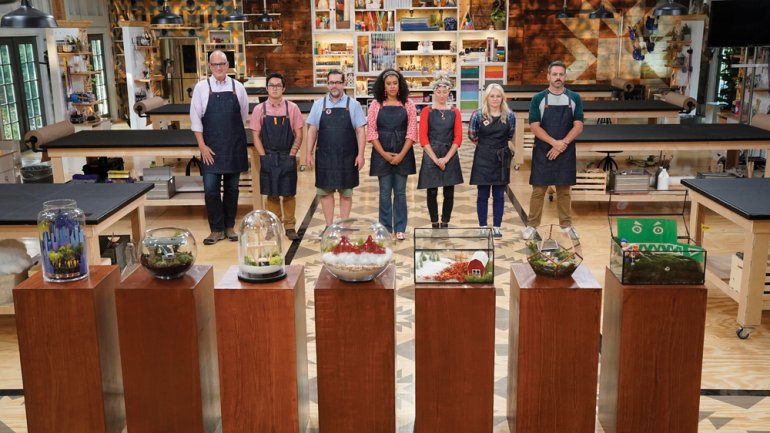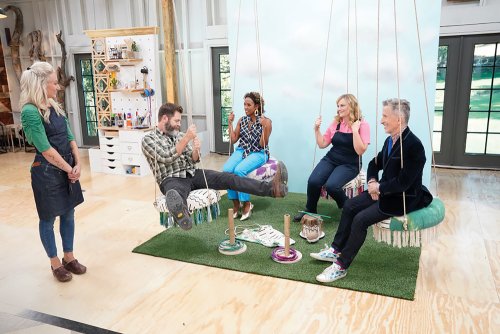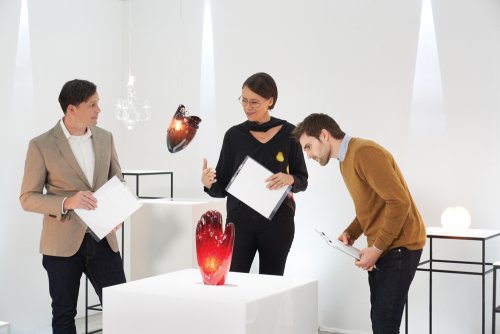Craft on TV
Craft on TV
American homes are hotbeds of creativity, and not just because artists and makers often convert their basements and garages into studios. Reality and educational TV, including streaming content, YouTube, and even social media, offer viewers practical instruction alongside something perhaps even more valuable: a taste of the discourse around different kinds of making from professionals in different fields. The physical sites for formal craft education, be they university art departments or community studios, tend to serve specific populations. TV, on the other hand, can and does reach anyone with access to the internet or a cable signal.
When The Great British Baking Show (known as The Great British Bake Off in the UK) premiered in the US in late 2014, viewers were enchanted by how kind the contestants – each an amateur baker – were to one another. The pointed lack of an adversarial ethos, enhanced by scenes of competitors actually helping each other when in a bind, helped launch the show into “instant classic” status. It’s educational, too: the contestants are tasked with challenging recipes from all over the world, giving viewers a chance to learn about technique, ingredients, flavors, and the science behind a perfect bake. The format caught on, and in 2018, Making It premiered on NBC. The show, which debuted its second season in December, switches bakers with crafters and recipes with creative prompts. At the end, one wins $100,000 and the title of Master Maker.
Making It bears so much similarity in structure and tone to GBBS that it could trigger a Pavlovian response, sending viewers running to the kitchen to check their household supply of eggs and unsalted butter. Rows of contestants stand at rectangular tables inside a cheery workspace, tools and supplies at the ready. A pair of hosts (comedic actors Amy Poehler and Nick Offerman, an accomplished woodworker) gamely do a bit of schtick as they describe the latest challenge, all puns intended. Contestants try to stay cheerful as they work under pressure, but their projects require creativity, a steady hand, strategic thinking, and time management. Here, “Crafting” with a capital C is center stage; contestants often work with mass-market supplies and materials such as hot glue and felt. Challenges involve creating holiday decorations and themed sheds rather than the sort of achingly subtle, room-sized textile installations that are at home in the contemporary art world. And much like GBBS, the show’s warmth and positivity has attracted viewers. As New York Times critic Margaret Lyons wrote following its 2018 debut, “a weekly dose of glitter and whimsy and some words of inspiration from Ms. Poehler and Mr. Offerman are completely and totally refreshing.”
In July, 2019, and hot on the heels of Making It, Netflix viewers got their first taste of Blown Away, in which ten accomplished glassblowers compete for a $60,000 prize and a residency at the Corning Museum of Glass. Though the shows sound similar in premise – both could credibly be described as “competitive televised crafting” – the two programs could not be more different. Where Making It is tidy, colorful, and funny thanks to the affable hosts, Blown Away is glass-blowing vérité. Contestants sweat as they anxiously try to beat the clock without accidentally dropping their delicate creations, hollering “behind you!” so as not to crash into each other, all while flames billow and metal tools clang in the background. The effect is dramatic. “There is no better way to spend a too-hot summer day than holed up in my apartment, watching people melt sand,” Rachel Syme wrote in her New Yorker review of the show. (Fans of the program will be pleased to know that Netflix is working on its second season although the release date has not yet been made public.)
People have loved educational how-to programming on craft and craft-adjacent skills for decades, and in its early days, PBS found its footing in part by pioneering the genre. Their shows are now the stuff of legend: Julia Child’s The French Chef (1963 – 74) made an intimidating culinary tradition approachable for American viewers and presented Child herself as a model of appealing, cleaver-wielding kitchen confidence. Potter Susan Peterson’s pioneering “Wheels, Kilns and Clay,” which aired on two public channels in California in 1968 and ’69 brought half-hour ceramics demonstrations to a broad viewing public. Bob Ross’s therapeutic The Joy of Painting (1983 – 94) offered viewers practical landscape painting techniques that were formulaic enough to be replicated with practice. And This Old House, the perennial inspiration and warning to would-be renovators of historic homes is – incredibly – still on the air fifty years after its 1979 premier. Each of these shows is informative, wholesome, and relaxing to watch.
But Martha Stewart, whose syndicated TV show Martha Stewart Living ran from 1993 – 2004, transformed how-to programming from relatively low-stakes, skilled demonstrations into displays of aesthetic refinement and technical perfection. Crucially, in addition to embarking on home improvement projects, cooking, and baking on her show, she introduced a particular understanding of “crafting” to a broad audience. For Stewart, the term suggests the ongoing practice of an eager, well-prepared, and inventive person with well-organized tools and supplies on hand, the skills to wield them effectively, and the good taste create something attractive. Her approach helped to elevate homemaking for the masses to a refined, professional level.
Both on TV and in her eponymous magazine, Stewart demonstrated how to make labor-intensive seasonal crafts that were almost too exhausting to watch (one episode had her making Thanksgiving gourd candles with a cordless drill.) She made Easter tablescapes, seasonal wreaths, complex ribbon decorations, and even lampshades. The curious thing about Stewart’s crafting segments, due in large part to the steely resolve of her on-camera delivery, is that while activities like wreath-making are arguably less practical or necessary than home renovation or cooking dinner, she tackled them with much greater intensity than any PBS how-to show. Where Julia Child was a relatively unconcerned proponent of the five-second rule, Stewart was exacting, enhancing the relative importance of her endeavors by sheer force of perfectionism.
Making It and Blown Away are, in a sense, the descendants of all of these programs. And what they represent on screen are two equally vital yet totally different approaches to craft in real life. Both shows are set up as competitions, and, as in GBBS, one contestant is given a special commendation for excellent work each week, while another is sent home. Makers are given different challenges to elicit varied skills and to push their creativity. The contestants’ work is examined by judges at each stage of the competition, and evaluated according to the criteria or “creative brief” of the challenge. In the last episode, a winner is crowned.
That’s more or less where the similarities end. Where Making It fully embraces the fun and frivolity of “crafting” as an artful leisure activity, Blown Away is firmly rooted in the professional glass art world. The main judge (she’s referred to on the show as the “resident evaluator”) is esteemed artist, professor, and recently named American Craft Council Fellow Katherine Gray. As a judge, she makes no bones about her taste. In an early episode, Gray comments that a contestant’s realistic sculpture of a whale looks like something from a “gift shop” (it’s implied that this is a criticism) and makes it clear that she’s looking for work that’s less literal or sentimental. Contestants who make the sort of work one might see “in a gift shop” are the first to be eliminated.
On Making It, by contrast, gift shop cred goes a long way. The series’ contestants are more typical “crafters” in the Martha Stewart vein, with varied expertise in paper, woodwork, and quilting, among other skills. And instead of a milieu where judges’ authority is derived from associations with traditional bastions of art world gatekeeping, such as museums, galleries, and universities, the judges on Making It are retail gurus. The first season’s judges are Simon Doonan, legendary designer of Barney’s window displays and a style columnist for Slate, and Dayna Isom Johnson, Etsy’s in-house trend expert. The stakes here are not lower than Blown Away’s, but different. The pair judges one contestant’s unicorn taxidermy sculpture (in which a crafted unicorn head is mounted on a plaque, like a non-violent hunting trophy) a bit harshly, not because it’s kitschy, but because the motif is one already widely found on Etsy. Originality counts, even if minimalism doesn't.
Even though Making It and Blown Away look at craft differently, they both have helped to foster wider appreciation for handwork and boosted the careers of their competitors. Philadelphia glassblower Alexander Rosenberg was one of the contestants on Blown Away (spoiler alert: he came in third) and his experience, from seeing the call for applicants, to auditioning, to competing and now navigating his professional life as a Netflix persona, reveals much about what television can offer both artists and the viewing public where craft is concerned. “The ad looked rather low-rent in terms of production value, and there were some questions that sounded a little trashy,” he says about applying for the show. “For example, they asked, ‘How would your enemies describe you?’ and a few other questions pointing toward a focus on interpersonal drama.” But as filming began, he was struck by the professionalism of the crew, and though nervous at times, he enjoyed the process. Since the show aired, he says he’s gained about 30,000 new Instagram followers and received inquiries about commissions. He gets emails from kids who want to try glass blowing because of what they saw on the show. For him personally, this has meant a wider audience for his work and more opportunities. For glass, it has meant greater interest in the field and more visibility for some of the institutions featured in the show, such as Pilchuck Glass School and the Corning Museum of Glass.
Plus, there’s value in a general audience watching the dynamic of different opinions play out between Blown Away host Nick Uhas, a former Big Brother contestant and YouTube star who tends to like the “gift shop” aesthetic, and judge Katherine Gray, whose preferences represent a more rarified sensibility. Viewers don’t have to agree with either of them, but by listening to their exchanges, they can gain insight into the opaque tension where the cash wrap meets the white cube gallery. What makes an object fit for consideration by a gallery? Conversely, what might make it appealing to a wide range of consumers in a retail context? Are those traits mutually exclusive? Makers are frequently left out of these sorts of conversations, and more apt to get a “yes” or a “no” rather than a “why” when submitting their work for consideration.
None of the contestants on Blown Away attempt a meta critique of aesthetics in the studio glass world by crafting a tongue-in-cheek series of, say, autumnal glass pumpkins, then presenting them unironically to Katherine Gray with a flawless poker face. And in a way it’s a shame that didn’t happen, because it could have elicited a terribly awkward and incredibly valuable conversation about taste, making and selling things, and earning a living as a maker. Proponents of kitsch and sweet sentiments tended to be voted off the island early on Blown Away, not unlike like GBBS contestants who couldn’t tell when their sponges are overbaked. Here, the ability to strike the right note where taste is concerned is in and of itself a skill, though this is never articulated outright.
Taken together, Blown Away and Making It represent a new kind of televised educational programming, not necessarily in terms of practical skill-sharing, but in that they lift the veil on the way different kinds of objects are understood and interpreted by people in different professional contexts. And that’s a challenge that the ever-expanding world of binge-worthy streaming television is uniquely well-suited to address. We could use more programs like them.
Editor's Note: A shorter version of this piece appeared in the February/March 2020 issue of American Craft.




